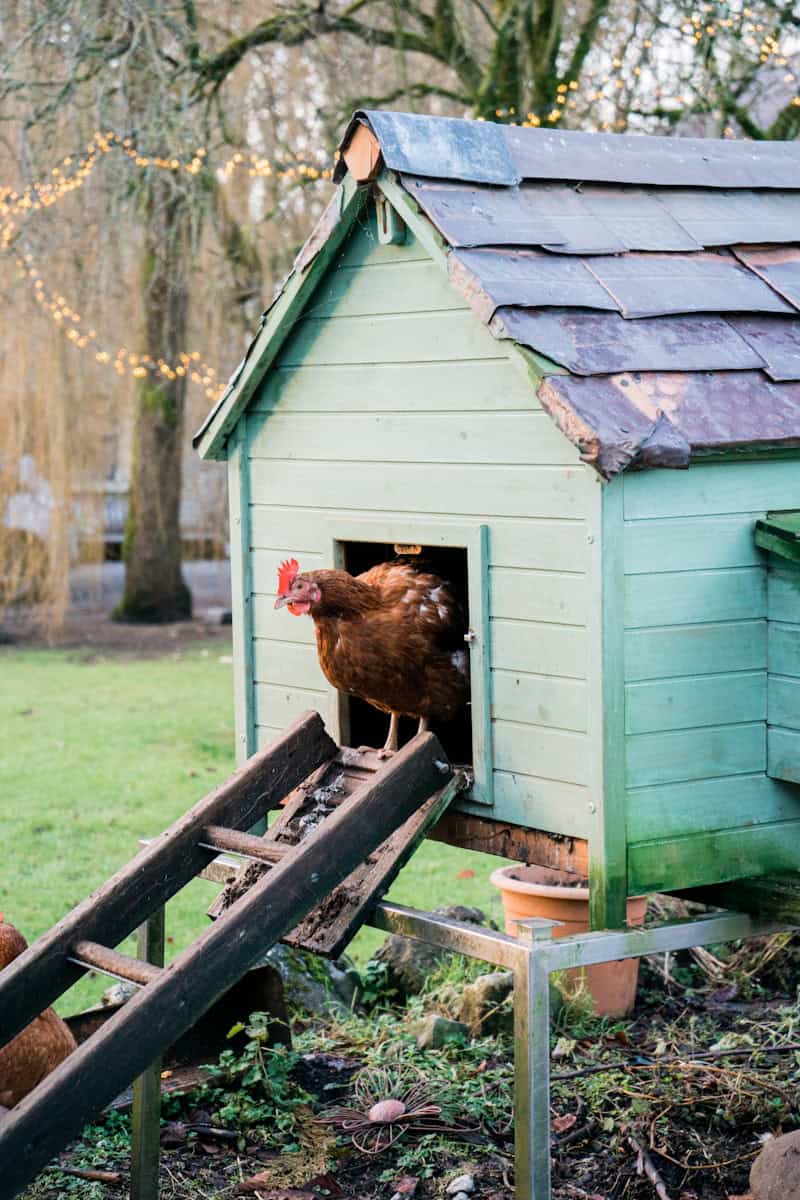Building a chicken coop can be a fun and rewarding DIY project. It’s not only a great way to ensure a safe and comfortable home for your hens, but it can also save you money compared to buying a pre-made coop. You’ll need to gather some basic materials like wood, nails, and chicken wire, and you should start by choosing a design that fits your space and needs.
Start by laying a solid foundation to ensure your coop lasts. Use treated lumber for a sturdy frame and make sure the floor is raised off the ground to keep your chickens dry. For the walls, plywood works well and is easy to cut and assemble. Create openings for windows and vents to allow fresh air to circulate.
Securing the coop is vital to protect your chickens from predators. Install strong latches on all doors and windows, as raccoons and other animals can be surprisingly clever. Cover any open areas with chicken wire and bury the wire a few inches underground to prevent animals from digging in. For more detailed plans and tips, you can check out this guide or explore other DIY plans like these.
Creating a Cozy Home for Your Flock: Chicken Coop Construction
Choosing the Right Location
Selecting the ideal spot for your chicken coop is crucial. Consider these factors:
- Sunlight: Chickens need sunlight for warmth and vitamin D. Ensure the coop receives ample sunlight throughout the day.
- Drainage: Avoid low-lying areas prone to flooding. Ensure proper drainage to keep the coop dry.
- Protection: Choose a location sheltered from harsh winds and predators. Consider installing a fence for added security.
Designing Your Coop
A well-designed coop should prioritize the comfort and safety of your chickens. Consider these essential features:
- Size: Allow at least 4 square feet of space per chicken inside the coop and 10 square feet in the run.
- Ventilation: Adequate ventilation is vital to prevent the buildup of harmful gases.
- Roosts: Provide sturdy roosts for sleeping, preferably made of smooth wood.
- Nesting boxes: Include one nesting box for every three hens, filled with soft bedding.
- Feeding and watering stations: Place food and water containers in easily accessible locations.
- Predator proofing: Ensure the coop is secure against predators like raccoons, foxes, and hawks.
Choosing Materials
The materials you choose will impact the durability and functionality of your coop. Here are some popular options:
- Wood: A classic choice for chicken coops, wood provides good insulation and is easy to work with.
- Metal: Metal is durable and can withstand harsh weather conditions.
- Plastic: Plastic is lightweight and easy to clean, but may not be as durable as other materials.
Building Your Coop
Follow these steps to build your chicken coop:
- Lay the foundation: Start by creating a level base using concrete blocks or gravel.
- Construct the frame: Build a sturdy frame using wood or metal, ensuring it’s square and level.
- Attach the walls and roof: Use plywood or other suitable materials to enclose the coop.
- Add the door and windows: Install a secure door and windows for ventilation and light.
- Build the nesting boxes and roosts: Construct these inside the coop, ensuring they are comfortable and accessible.
- Create the run: Attach a secure run to the coop, providing ample space for your chickens to roam.
Additional Tips
- Regular cleaning: Clean the coop regularly to prevent the buildup of harmful bacteria and parasites.
- Protection from weather: Ensure the coop is insulated to protect your chickens from extreme temperatures.
- Fresh water and food: Provide clean water and nutritious food daily.
- Health checks: Monitor your chickens for any signs of illness or injury.
Enjoy Your Happy Flock!
By following these guidelines, you can create a safe and comfortable home for your chickens, ensuring they thrive and provide you with fresh eggs for years to come.
Planning Your Chicken Coop
Planning your chicken coop involves several key steps, including determining the size and location, understanding local laws, and selecting the right design. These steps ensure your coop is suitable for your chickens and fits your backyard.
Choosing the Right Size and Location
The size of your chicken coop is determined by the number of chickens you plan to keep. A good rule is to provide 2 to 3 square feet per chicken inside the coop. For the outdoor run, plan for at least 8 to 10 square feet per chicken.
When choosing the location, pick a spot with good drainage to avoid mud and puddles. A sunny location helps keep the coop dry. Make sure the area is secure from predators. If you live in an urban area, consider how much noise the chickens will make and the impact on neighbors.
Understanding Local Ordinances
Before building a chicken coop, it’s important to check local ordinances. Cities and towns often have rules about keeping chickens. These rules can set limits on the number of chickens, types of homes allowed, and how far the coop must be from property lines.
To find out about local laws, visit your city’s website or contact the local zoning office. Some places may require a permit to keep chickens. Knowing the rules can help avoid fines and other issues.
Selecting a Design
The design of your chicken coop should provide a safe and comfortable space for your chickens. A basic coop should include a nesting box, perch, and enough ventilation to keep the coop fresh and dry. Chicken coop plans can vary from simple to elaborate.
When selecting a design, think about how easy the coop will be to clean. Elevated coops make cleaning easier by letting droppings fall to the ground. Consider designs with easy access for gathering eggs and maintaining the inside.
Urban areas may need a more compact design to fit smaller backyards. Portable or movable coops can be handy for urban chicken keepers.
Gathering Materials and Tools
Building a chicken coop requires careful preparation. Here, we will list the necessary materials and tools to ensure the construction process goes smoothly.
Essential Materials Checklist
To build a sturdy chicken coop, start with wood. Use pressure-treated lumber for the frame to prevent rot. Next, gather plywood panels for the walls and hardware cloth for added ventilation.
Materials:
- Pressure-treated lumber
- Plywood panels
- Hardware cloth
- Chicken wire for the enclosure
- Roof shingles or corrugated roofing
- Nesting boxes
- Screws and hinges
Include extra materials like clamps for holding pieces in place and sandpaper for finishing touches. You may need PVC pipes if you plan to add a movable roof or other unique features.
Required Tools for Construction
Good tools are essential for construction. Start with a saw or circular saw to cut your wood to size. A drill will be needed for attaching screws. A screwdriver can also be helpful for smaller tasks.
Tools:
- Circular saw
- Drill
- Screwdriver
- Tape measure
- Hammer
- Level
- Clamps
- Sandpaper
A measuring tape and level ensure your coop is even and stable. Use a hammer for securing nails and a clamp to hold materials in place while working. Lastly, sandpaper is used to smooth out rough edges.
Building the Chicken Coop
Building a chicken coop requires careful planning and execution to ensure chickens are safe, comfortable, and productive. Essential tasks include constructing the frame, installing roosting bars and nesting boxes, ensuring proper ventilation, and adding the roof.
Constructing the Frame and Panels
Start by selecting a suitable location with adequate space. Use treated 2×4 boards for durability. Build the frame, making sure it is square and level. Each side needs pieces of specific lengths. For example, one side may need a 50-inch leg, while another might need a 38 1/4-inch leg.
Once the frame is complete, attach panels to form the walls. Use plywood or similar materials. Make sure to leave openings for doors and windows. Secure every joint with screws or nails to enhance stability.
Installing Roosting Bars and Nesting Boxes
Roosting bars are crucial for keeping chickens happy. Place them at least 2 feet above the coop floor. Use sturdy, smooth wood for comfort. Space them 12 to 18 inches apart. This ensures chickens have enough room.
Nesting boxes provide a place for laying eggs. Position them a few inches above the ground and add straw for bedding. A good size is about 12×12 inches. Multiple boxes reduce crowding and stress.
Ensuring Proper Ventilation and Insulation
Proper ventilation prevents moisture and odor buildup. Install vents near the top of the coop. These allow hot air to escape while keeping the coop dry. Use mesh to cover vents to keep predators out.
Insulation is vital for temperature control. It keeps the coop warm in winter and cool in summer. Use materials like foam boards or spray foam. Make sure to cover all walls and ceiling areas to avoid drafts.
Adding the Roof and Finishing Touches
Use roof trusses to create a solid base for the roof. Angle each truss at 45 degrees and attach firmly to the frame. Secure a ridge rail along the top for added stability. Use waterproof materials like metal sheets or shingles to cover the roof.
Finish by adding coop doors and an access door for cleaning. Paint the exterior to protect against the weather. Ensure all doors have secure latches to keep predators out. Add some exterior paint to protect the wood. Lastly, do a thorough check to confirm everything is securely in place.
Ensuring Chicken Coop Safety and Accessibility
Building a chicken coop requires careful attention to safety and accessibility. Strong protection against predators and easy access for both chickens and their caretakers ensures a healthy and efficient environment.
Securing Against Predators
Protecting chickens from predators is crucial. Common predators like raccoons and hawks can harm the flock. To secure the coop, use hardware mesh instead of chicken wire. The mesh should cover all openings, including windows and vents, to prevent entry. A secure automatic chicken coop door can help keep predators out, especially at night.
Install the coop on high ground to avoid flooding and moisture, which can attract pests and cause diseases. Ensure good ventilation while preventing drafts. Nest boxes should be elevated to keep eggs safe. Frequent checks can help identify and repair any weak spots in the coop.
Accessibility for chickens and caretakers is important too. Ensure easy access to egg-laying areas and place feeders and waterers where chickens can reach them easily. Ramps with non-slip surfaces will help chickens avoid injury. Regular cleaning and maintenance ensure a healthy environment for the backyard flock.
Frequently Asked Questions
Learn how to start building a chicken coop, save money during construction, and keep your chickens safe and happy.
What are the essential steps for building a chicken coop for beginners?
First, select a good location. It should be dry and well-drained. Then, gather materials such as wood, screws, and wire mesh. Follow a step-by-step guide to build the coop frame, walls, roof, and nesting boxes. Lastly, add final touches like water and feed containers.
What is the most cost-effective way to construct a chicken coop?
Use recycled materials like pallets and old wood. These can often be obtained for free or at a low cost. Opt for simple designs that use fewer materials. You can also save money by doing all the work yourself. Check out more ideas for low-budget chicken coops.
Can you provide a guide for building a chicken coop with accommodations for 6 chickens?
Each chicken needs 2-3 square feet inside the coop and 8-10 square feet in an outdoor run. For 6 chickens, the coop should be at least 12-18 square feet inside. Make sure the run is 48-60 square feet. Look for more details on this chicken coop guide.
Why is it important to elevate chicken coops off the ground?
Elevating the coop keeps chickens safe from predators. It also improves drainage and reduces moisture inside the coop. This helps prevent mold and other issues that can cause disease.
How can you construct a chicken coop in a way that allows chickens to be self-sufficient if left alone for a week?
Set up automatic feeders and waterers. Ensure the coop is predator-proof. Provide enough space for each chicken to move around. Make sure there is plenty of ventilation. Regularly clean the coop to prevent any buildup of waste.
What are the considerations for building a chicken coop in a video game environment, such as Stardew Valley or Minecraft?
In Stardew Valley, you need wood, stone, and money to build a chicken coop. Place the coop near crops for easy access. In Minecraft, use blocks to build walls and a roof. Make sure it is secure to keep mobs out. Adjust designs based on the game’s mechanics.







